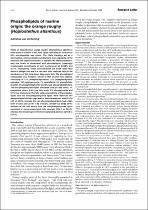JavaScript is disabled for your browser. Some features of this site may not work without it.
- ResearchSpace
- →
- Research Publications/Outputs
- →
- Journal Articles
- →
- View Item
| dc.contributor.author |
De Koning, AJ

|
en_US |
| dc.date.accessioned | 2007-03-16T07:35:19Z | en_US |
| dc.date.accessioned | 2007-06-07T10:05:57Z | |
| dc.date.available | 2007-03-16T07:35:19Z | en_US |
| dc.date.available | 2007-06-07T10:05:57Z | |
| dc.date.issued | 2005-09 | en_US |
| dc.identifier.citation | De Koning, AJ. 2005. Phospholipids of marine origin: the orange roughy (Hoplostethus atlanticus). South African Journal of Science, Vol. 101, 10 September, pp 414-416 | en_US |
| dc.identifier.issn | 0038-2353 | en_US |
| dc.identifier.uri | http://hdl.handle.net/10204/1963 | en_US |
| dc.identifier.uri | http://hdl.handle.net/10204/1963 | |
| dc.description.abstract | Fillets of deep-skinned orange roughy (Hoplostethus atlanticus) were found to contain 5.46% total lipids consisting of as much as 93% non-digestible wax esters. The fillets therefore act as a mild laxative, which probably contributes to their popularity on the American and Japanese markets. In addition, the fillets had remarkably low levels of cholesterol and phospholipids (seemingly irreplaceable constituents of cell membranes) of 0.033% and 0.17%, respectively. These concentrations are much lower than those of pelagic fish and it is not clear what replaces them in the membranes of this long-lived, deep-water fish. The phospholipid composition was, however, similar to that of other fish species, consisting of 51% phosphatidylcholine, 22% phosphatidylethanolamine, 10% sphingomyelin, 7% cardiolipins, 5% phosphatidylinositol, 3% phosphatidylserine and 2% lyso phosphatidylcholine. The non-phosphorylated lipids consisted of 96.3% wax esters, 1% cholesterol esters, 0.6% free fatty acids, 2% triacylglycerols and 0.1% free cholesterol. The fatty acid compositions of the phospholipids and the non-phosphorylated lipids were different, the phospholipids having a high level of docosahexaenoic acid (C22:6 n-3) of 40.4%, whereas the non-phosphorylated lipids had a high level of oleic acid (C18:1 n-9) of 58.3%. Almost two thirds of the alcohols of the wax esters from the non-phosphorylated lipids consisted of mono-unsaturated fatty alcohols (C14:1 to C24:1), whereas the remaining one third were saturated alcohols (C16:0 to C24:0). | en_US |
| dc.format.extent | 199204 bytes | en_US |
| dc.format.mimetype | application/pdf | en_US |
| dc.language.iso | en | en_US |
| dc.publisher | Acad Science South Africa A S S AF | en_US |
| dc.rights | Copyright: 2005 Acad Science South Africa | en_US |
| dc.subject | Hoplostethus atlanticus | en_US |
| dc.subject | Fish species | en_US |
| dc.subject | Wax esters | en_US |
| dc.subject | Phospholipids | en_US |
| dc.subject | Non-phosphorylated lipids | en_US |
| dc.subject | Food sciences | en_US |
| dc.title | Phospholipids of marine origin: the orange roughy (Hoplostethus atlanticus) | en_US |
| dc.type | Article | en_US |
| dc.identifier.apacitation | De Koning, A. (2005). Phospholipids of marine origin: the orange roughy (Hoplostethus atlanticus). http://hdl.handle.net/10204/1963 | en_ZA |
| dc.identifier.chicagocitation | De Koning, AJ "Phospholipids of marine origin: the orange roughy (Hoplostethus atlanticus)." (2005) http://hdl.handle.net/10204/1963 | en_ZA |
| dc.identifier.vancouvercitation | De Koning A. Phospholipids of marine origin: the orange roughy (Hoplostethus atlanticus). 2005; http://hdl.handle.net/10204/1963. | en_ZA |
| dc.identifier.ris | TY - Article AU - De Koning, AJ AB - Fillets of deep-skinned orange roughy (Hoplostethus atlanticus) were found to contain 5.46% total lipids consisting of as much as 93% non-digestible wax esters. The fillets therefore act as a mild laxative, which probably contributes to their popularity on the American and Japanese markets. In addition, the fillets had remarkably low levels of cholesterol and phospholipids (seemingly irreplaceable constituents of cell membranes) of 0.033% and 0.17%, respectively. These concentrations are much lower than those of pelagic fish and it is not clear what replaces them in the membranes of this long-lived, deep-water fish. The phospholipid composition was, however, similar to that of other fish species, consisting of 51% phosphatidylcholine, 22% phosphatidylethanolamine, 10% sphingomyelin, 7% cardiolipins, 5% phosphatidylinositol, 3% phosphatidylserine and 2% lyso phosphatidylcholine. The non-phosphorylated lipids consisted of 96.3% wax esters, 1% cholesterol esters, 0.6% free fatty acids, 2% triacylglycerols and 0.1% free cholesterol. The fatty acid compositions of the phospholipids and the non-phosphorylated lipids were different, the phospholipids having a high level of docosahexaenoic acid (C22:6 n-3) of 40.4%, whereas the non-phosphorylated lipids had a high level of oleic acid (C18:1 n-9) of 58.3%. Almost two thirds of the alcohols of the wax esters from the non-phosphorylated lipids consisted of mono-unsaturated fatty alcohols (C14:1 to C24:1), whereas the remaining one third were saturated alcohols (C16:0 to C24:0). DA - 2005-09 DB - ResearchSpace DP - CSIR KW - Hoplostethus atlanticus KW - Fish species KW - Wax esters KW - Phospholipids KW - Non-phosphorylated lipids KW - Food sciences LK - https://researchspace.csir.co.za PY - 2005 SM - 0038-2353 T1 - Phospholipids of marine origin: the orange roughy (Hoplostethus atlanticus) TI - Phospholipids of marine origin: the orange roughy (Hoplostethus atlanticus) UR - http://hdl.handle.net/10204/1963 ER - | en_ZA |






